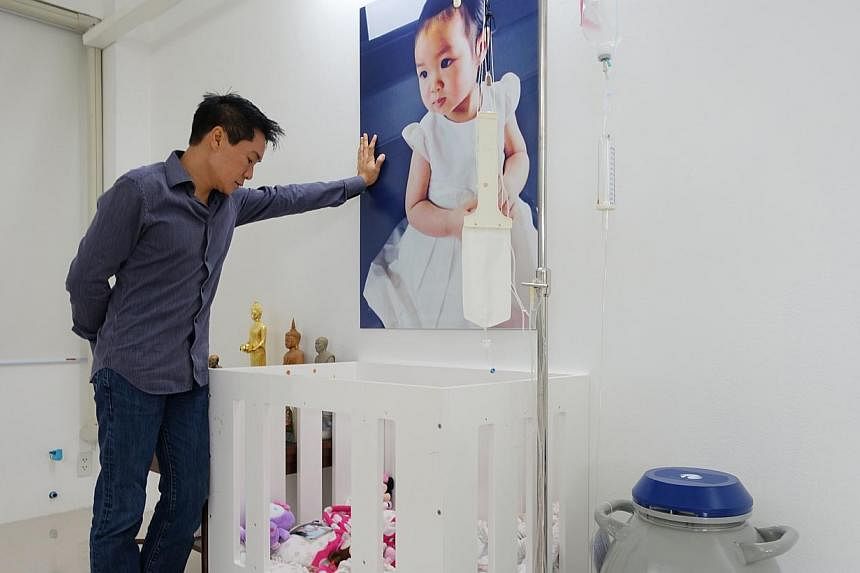A MONTH short of turning three, Thai toddler Matheryn Naovaratpong succumbed to brain cancer in January and became the first minor to be cryogenically frozen. Her Bangkok-based parents hope science will enable her to be brought back to life some time in the future.
The family used the services of the Arizona-based non-profit organisation, Alcor Life Extension Foundation, which now manages a total of 134 such preserved human beings. The oldest kept in one of its thermos bottle-like vats was 102 at the time of death and its best known is arguably American baseball legend Ted Williams.
"Kryos" in Greek means "icy cold". People who choose cryopreservation want another shot at life, wagering on successful reanimation in some future period, which would not be possible if all that remains of them are bones or ashes.
Alcor charges a US$770 (S$1,020) annual membership fee, plus US$200,000 at death. In return, it guarantees that wherever you die, it will be on hand to get your body into frozen hibernation, pronto.
It has more than 1,000 living members who would point to how countless women have had healthy babies using cryopreserved embryos. Today, cryopreserving corneas, sperm, eggs and embryos - then rewarming them for successful use - is routine.
Still, doing that to a whole organ - let alone a whole body - is several degrees of difficulty higher. After all, frozen embryos are usually just eight cells in size.
Technically, embryos are not actually frozen, but vitrified, which involves first substituting the water inside their cells with a cryoprotectant or anti-freeze solution. This allows the embryo to be cooled to minus 120 deg C, without ice crystals forming in its cells and possibly causing the cells to burst.
Alcor uses vitrification, with machines running cryoprotectant solutions through the circulatory system of the person who has just died to remove and replace up to 60 per cent of the water in his cells. This reduces the likelihood of ice crystals forming inside cells as the body is cooled down progressively.
So vitrification cools the body quickly enough for it to become like solid glass, but with as few ice crystals as possible forming in cells that may lead to organ damage. The body is then immersed in a large metal vat filled with liquid nitrogen, to be kept at minus 196 deg C indefinitely.
However, whole-body vitrification poses some future problems.
First, a cryoprotectant is a toxic chemical, and a lot of it is needed to replace the water in the body. Filling trillions of cells in the body with anti-freeze means that scientists in future will have to somehow get it out again and repair any damage it might have caused.
Second, flesh that is vitrified is solid and solids tend to contract in the cold. This can cause vitrified flesh to fracture into small pieces. So for successful reanimation in the future, scientists must be able to treat the toxicity and repair such fractures.
It must be noted that vitrification is done only after death. Starting the process when the person is still alive would lead to death, and whoever does it would be causing death or assisting a suicide, which is illegal in most places.
But why even think about vitrification before death? Well, it would be the best way to preserve the brain and therefore one's self-identity at reanimation. Under normal temperatures, brain death sets in within six to 10 minutes after the heart and breathing stop, which would deprive the brain of oxygen.
That's why Alcor must be on hand to begin vitrification immediately after the heart stops, but before any damage to the brain occurs. This could be arranged for a person dying from, say, breast cancer. But there is no such window of opportunity for a patient with inoperable brain cancer: If cancer destroys the brain, there won't be much of it left to preserve.
Most people feel that it is the mind which determines personhood and self-identity. Most also think the mind is grounded in the brain. So it seems that preserving the brain offers the individual the best shot of being the same person he was before at reanimation.
That is why vitrification before brain death sets in is crucial. To take it one step further, doing so even before the heart and breathing stop would improve the chances of preserving brain structure and function even more.
But freezing someone at his request before his heart and breathing stopped would be assisted suicide. Thus, specific legislation permitting that under well-defined circumstances, like where the brain is still functioning in brain cancer, might help.
Such an "assisted suicide" exception might be justified since it is chosen not so that one dies, but in the hope of returning to life in future. Vitrification before death would arguably be just pausing life as opposed to rendering oneself permanently dead. If so, legalising vitrification before clinical death may be upheld for the terminally ill.
Against this is the high cost of hope and the fact that no one knows yet how to reanimate a vitrified body. Its likelihood of success seems minuscule at present - but better than the zero chance with burial or cremation.
The dying who can afford what Alcor charges may like to regard it as a low-risk, high-return wager.

